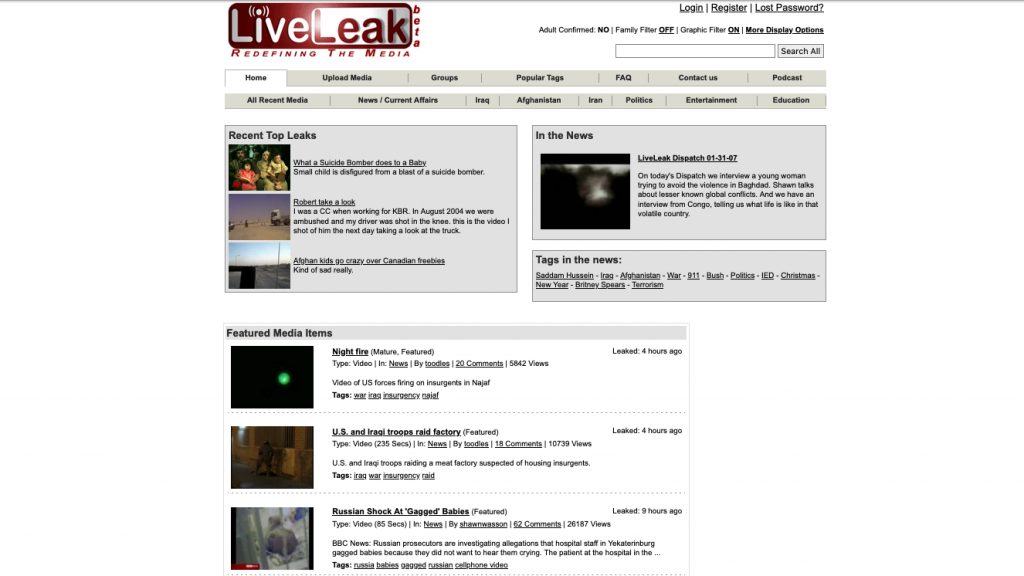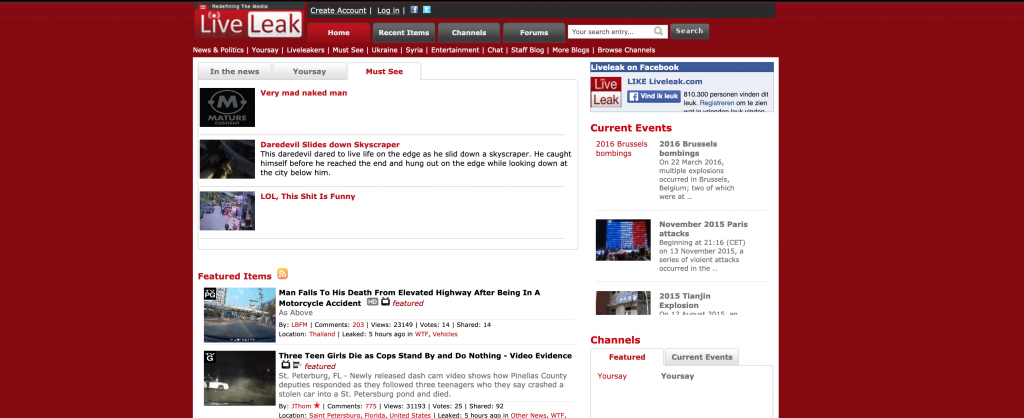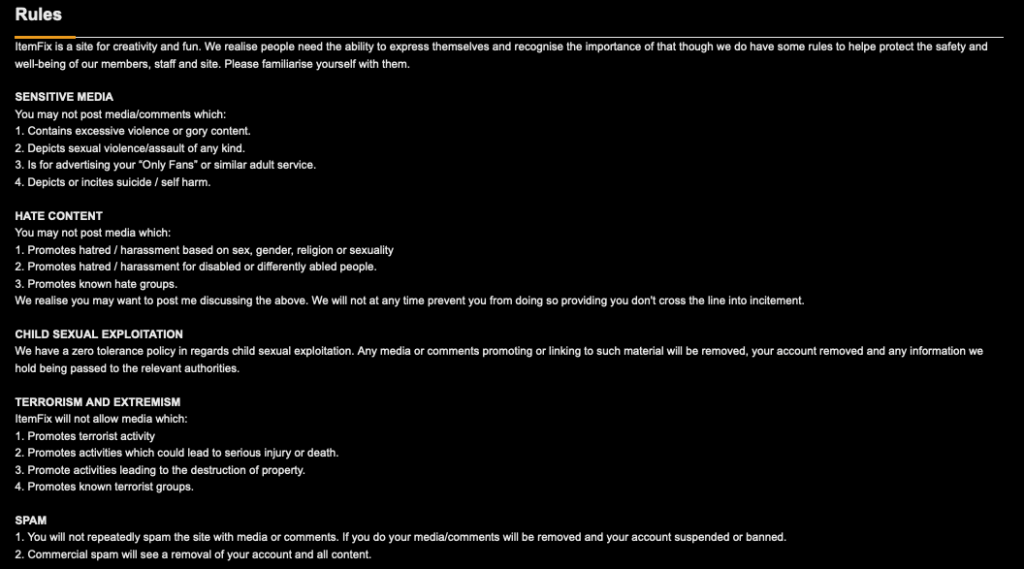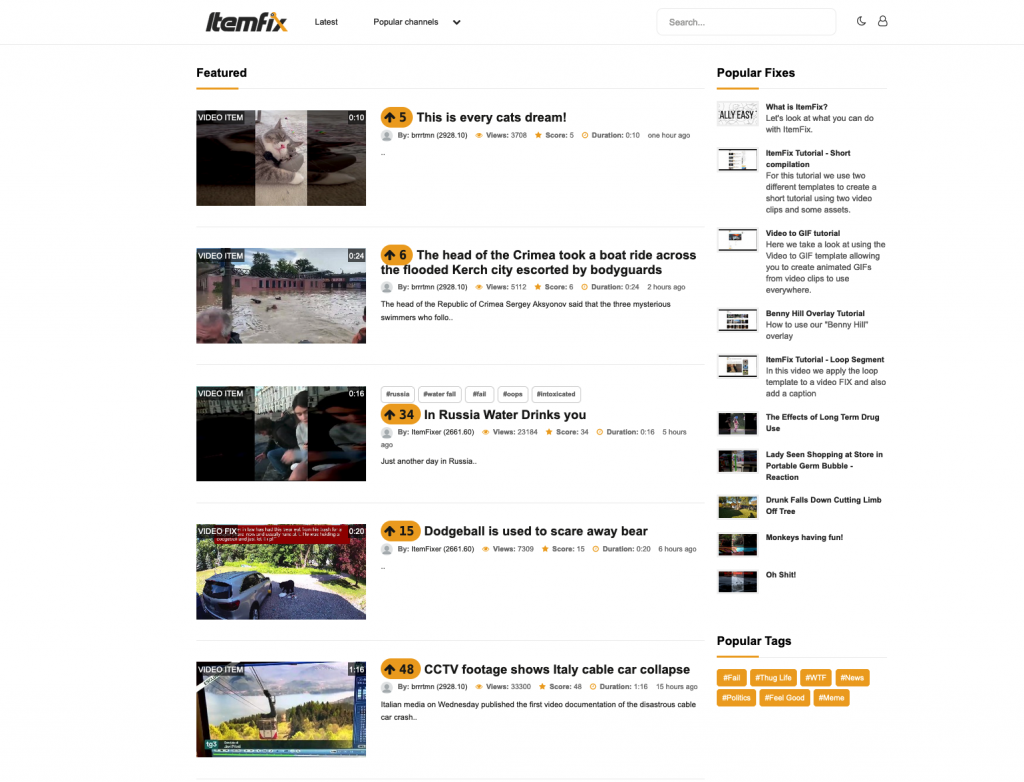In early May 2021, the internet lost a controversial yet vital part of its history. Seemingly out of the blue, video hosting platform LiveLeak shut down. It was a staple website for gore content, especially among millennials or other early internet users, and for its information transparency and unrestricted censorship to citizen journalists, whistleblowers and hacktivists. The seemingly disparate demographic of LiveLeak is intertwined by neoliberal ideals foundational to the internet: information wants to be free, individual freedom of expression and free-market capitalism.
In the current digital climate, however, these neoliberal ideals require habituation. Numerous alt-tech platforms premised on unrestricted censorship rise and fall through the co-optation by those groups subjected by the consequences of free information and individual freedom: (right-wing) extremist, racists or conspiracists. In recent years, this form of habituating irresponsible behavior, immoralization and the disciplining of subjects is enclosed in the term digital hygiene. This euphemism for the developing field of digital biopolitics not only disciplines users, but extends to a broader context of controlling information freedom as well. LiveLeak now redirects to the new, more sanitized ItemFix.com: a website where visitors are encouraged to engage with uploaded content by remixing and re-uploading it, emphasizing participatory culture and memetics. More importantly, ItemFix has a strict content policy, something both Ogrish and LiveLeak firmly opposed. Tracing the maturity of LiveLeak from Ogrish to ItemFix creates an allegorical umbilical cord connected to the internet’s coming of age.
Childhood
During LiveLeak’s infancy as Ogrish, the website was related to the Shock blog or gore porn discourse (you might remember rotten.com or Goatse). The website hosted videos of atrocities such as executions, suicides, beheadings, rape, general mutilation. It can also be labeled as dark tourism by providing fetishized sight. Gore porn is used metaphorically to instill some form of morality in the viewer’s mind. This is reminiscent of Susan Sontag’s theories on metaphors but did not resist Ogrish and its visitors to become a market that fetishized unethical video content. The spectatorship of body horrors, as Tait calls it, was the main characteristic of the website, where context and significance seemed to be shed as excess skin on a snake.
As Orgish became a pre-teen between ’05 and ’06, Tait recognized that it wished to reposition its views on the spectatorship of body horror in a way that’d become more political. The shift of making body horrors more ethical was positively embraced, as legacy media used (edited) content from the website in news items on US invasion in Iraq (such as the beheading of Nick Berg). These changes, its newsworthiness appeal and moralization of gore content became the culmination that leads Ogrish to the high school and college stage of its life: LiveLeak.
Transgressive teen or ambitious adolescent?
While LiveLeak was the result of the domestication and moralization of gore porn, its fetishizing sight still remained under the hood. This led to a dichotomy in how the same content is perceived. CCTV footage leaked information or just straightforward captures of unethical activity: LiveLeak offered a platform for all types of content in name of redefining the media, as their tagline goes. Closing in their relationship to news, the platform and its content providers purposefully tried to establish itself as the cousin of the news who, by sifting through horrendous content, were destined to show what’s really going on. ‘[I]mages of atrocity are understood to make a call to conscience, to enable the viewer to bear witness to scenes cleansed from mainstream media through repressive standards of taste and decency,’ as Sue Tait puts it.
‘[I]mages of atrocity are understood to make a call to conscience, to enable the viewer to bear witness to scenes cleansed from mainstream media through repressive standards of taste and decency.
But because of its participatory nature and the increased interest in the platform–stemming from the moralized sight on gore content for the sake of newsworthiness– content of everyday life in non-Western countries started to form a genre, coinciding with citizen journalism. A significant amount of videos, for example, featured the working environments of Chinese construction or factory workers. The CCTV documented not only their poor and hazardous labor environments, which could be used by journalists but also recorded immanent disasters such as breaking pipelines, leaking liquid metals, explosions and so on. This narrative became so well-known on LiveLeak, it even made it into a TikTok meme.
Gore content was domesticated and conceptualized as ethical, new usage of the platform affordances made the demographics more heterogeneous and content could be recontextualized for political or activist means. Has LiveLeak reached the phase of adolescence? It did seem more mature in the sense that it was taken more seriously and value. Yet, it still balanced on the fissure between citizen journalism and this gore-induced fetishized gaze of body horror.
Being an alternative for news, featuring graphic content and having a supply and demand relationship of such circulating content, LiveLeak is easily wedged together with fringe networks such as 4chan and 8kun–which are not seen as mature, to say the least. In reality, it was more similar to Reddit, in that the platform held a significant position in the media landscape as an underdog. Along with the tolerant moderation, this unique position enabled LiveLeak to spread both graphic and extremist content far wider than imageboards. Dutch right-wing populist Geert Wilders utilized these affordances to broadcast his anti-Islam film Fitna. During the Christchurch shootings in New Zealand, telecom company Telstra denied access to LiveLeak (stitching it together with the imageboard) as means of minimizing the spread of the manifesto of ethnonationalist and terrorist Tarrant.
Gore, citizen journalism and hacktivism
Of course, the liberating element here is that news becomes democratized. Legacy news media’s censorship of gore content and even events that weren’t deemed newsworthy found a new platform to circulate through. Citizen journalism attempts to report the reality after the news media’s camera lens stopped rolling. They were the dirty or the explicit version of a song, where legacy news media signify the clean version without foul language. Saddam Hussein’s execution, the imagery of transgressive military activity in Iraq and Afghanistan and journalist James Foley’s beheading were all popular videos hosted and extensively viewed on LiveLeak. It also played an important role during the Arab Spring and the Syrian Civil War in 2011.
If LiveLeak had been around during the Gulf War, Baudrillard wouldn’t have claimed that it didn’t happen.
Around the same period, after anonymous users shared videos about war crimes in Iraq, British Prime Minister Tony Blair called LiveLeak a “pro-terrorist manipulating web site.” Similarly, in 2007, the former White House Press Secretary mentioned LiveLeak in his speech and underlined its “mass manipulating” characteristic. While these indicate the ‘reality’ behind global news events, street journalism was also a prime narrative. On-site reports and everyday captures hinged between journalist intent, lulz and graphic imagery. If LiveLeak had been around during the Gulf War, Baudrillard wouldn’t have claimed that it didn’t happen.

Screenshot of LiveLeak. Source: Internet Archive.
In this case, LiveLeak is the embodiment of fringe networks disseminating information to wider audiences beyond traditional discourse. It could therefore well be named among the endeavors of WikiLeaks. After the release of Collateral Murder, Wikileaks cemented the internet as an important participant of public political debate, often crossing over and grabbing headlines in legacy media. Milan’s chapter in the book Beyond WikiLeaks elaborates further on this. Similarly, LiveLeak played an equally important role during the Arab Spring and Syrian Civil War, as it allowed the information flow to reverse, from non-Western to the West, something Çömlekçi and Güney argue is a unique potential of the platform. Citizen journalism thus also closely relates to hacktivism. Which is another way LiveLeak was utilized.
Whistleblowers used LiveLeak as an intermediary to securely share their information anonymously while also increasing their audience and reach, operating behind the smokescreen of gore and citizen journalist content.
LiveLeak is not often mentioned in the discourse of information communication. It’s privy to the logics of citizen journalism, but that does not fully entail its relevancy when it comes to the digital dissemination of information. Its aim to provide an alternative flow of information thus also attracts those who utilize this for activist reasons: whistle-blowers and free information activists. Where WikiLeaks is founded upon the ideals of these information transparency activists, LiveLeak was not but did share some similar logics. This is why Whistleblowers used LiveLeak as an intermediary to securely share their information anonymously while also increasing their audience and reach. Whistleblower networks could operate behind the smokescreen of gore and citizen journalist content. The usability of LiveLeak thus is found in the midst of this trilateral demographic.
Both platforms contain a disruptive element to the flow and control of information. But while WikiLeaks maintained a close and contested relationship to journalism, the platform logics situated LiveLeak more in a social context. Metrics decided the popularity and thus visibility of videos, which allows for elements of memetics. Videos on animals could very well reach the home page, categorized in either ‘Must See’, ‘In The News’, or ‘Featured Items’. To overcome this dialectic between memetic videos and journalist content, features such as ‘Channels’ and ‘Current Events’ are introduced, indicating that the platform knows users come to LiveLeak for various reasons and want to adhere to both. LiveLeak is the intermediary, serving its purpose as a repository or additional source for journalism. Its relationship with journalism is similar to its relationship with whistleblowers: distant cousins who use their kinship only instrumentally.

Screenshot of LiveLeak (May 20th 2016). Source: Internet Archive
Whereas tax havens such as the Cayman Islands are utilized to avoid paying your monthly dues, LiveLeak functioned as an information haven where whistleblowers and citizen journalists could redirect their information through it to avoid possible tracing and thus prosecution. While YouTube is a year older, puberty hit LiveLeak earlier during their formative years. The latter can be seen as the transgressive teenager trying to provoke, either by suppressed information, shock-inducing content from places far away.
But why didn’t LiveLeak manage to hold more political?
The activism of WikiLeaks (and the transparency movement it ushered in) is not quite prevalent in the demographic of LiveLeak. Both have made legacy news as sources for information, albeit in a disproportionate matter. But while the content might be crossposted from the former to the latter to widen the scope, LiveLeak tends to lean on the fact that it’s reporting on spectacle. It’s the (graphic) images and not the context that get the clicks. Debord prophetically saw the ocularcentrist emphasis of images as the degradation of meaning in the society of the spectacle. LiveLeak provided the millennial generation with the explicit version of the spectacles we were served by legacy news media. The unauthorized video of Saddam Hussein’s execution, one might argue, serves as a more spectacular closure to the war in Iraq than the symbolic representations: presidential speeches, troops marching with flags or Saddam Hussein’s statue being torn down. Content on LiveLeak thus operates in two parallel (and somewhat contrasting) dimensions. On the one hand, the content relates as an explicit version to the spectacular horrors, maintaining its context. Simultaneously, the content is deconstructed of meaning and recontextualized akin to the spectacular or shock value the platform is known for. It illustrates once more how the moralization of gore content is problematized.
[The] emphasis on rendering spectatorship of graphic imagery as an antidote to the hygiene of mainstream press coverage potentially has significant consequences, as it enables viewers to avoid the moralizing frameworks [news media retain]. Tait, 2008
Middle Child Syndrome
Two groups congregating on a platform to both consume and circulate information positioned LiveLeak as a middle child in some ways. On the one hand, it was the transgressive and edgy older brother to YouTube. He guided you to more obscure content your parents didn’t want you to see. That same rebellious attitude is juxtaposed by his politically conscious and hacker-savvy older sibling WikiLeaks. Too indoctrinated by his own gore fetishization during his childhood as Ogrish, LiveLeak was not able to comply with the political strides of WikiLeaks, although the two did interact. This idea of middle child syndrome can be elaborated by the fact that LiveLeak followed various internet logics. Due to its inception in a specific transitional time from web 1.0 to 2.0, the platform was grounded on logics such as sociality, sharing, transparency, hacktivism, participatory culture and so on.
On the one hand, LiveLeak was the transgressive and edgy older brother to YouTube. He guided you to more obscure content your parents didn’t want you to see. That same rebellious attitude is juxtaposed by his politically conscious and hacker-savvy older sbiling WikiLeaks, too indoctrinated by his own gore fetishization during his childhood as Ogrish.
Like Wikileaks, LiveLeak’s aspects of citizen journalism share similarities to hacktivism, but with notions of alternative countercultural and digital citizen media models which had introduced easy participatory content production (Brevini et al 4). In addition to these notions, LiveLeak contained logics of social media and memetics. Virality plays an important role which was endorsed by a like and viewing system to categorize videos, emphasizing the sociality of the platform. Metrics decided the popularity and thus visibility of videos, which allows for elements of memetics. Videos on animals could very well reach the home page, categorized in either ‘Must See’, ‘In The News’, or ‘Featured Items’. To overcome this dialectic between memetic videos and journalist content, features such as ‘Channels’ and ‘Current Events’ are introduced, indicating that the platform knows users come to LiveLeak for various reasons and want to adhere to both.
For the dissemination of information, content was decontextualized by the platform’s hacker ethos, which holds an agnostic stance towards information. The journalist ethos requires contextualization, which WikiLeaks did actively adopted and LiveLeak attempted. Where citizen journalism might be the intention, in a McLuhan-esque way the platform appropriates the gore content for the demand present on LiveLeak, making it harder to be politically disruptive. Poe’s law learns us that without clear indication, it is impossible to read an author’s intention. The content is stripped of its context as soon as it circulates on LiveLeak. The genetic code LiveLeak adopted from Ogrish seemed to influence its ability to become more activist. The lack of collective activism (collactivism) stems from the fact that the platform serves the visitor, the viewer, the subject of the spectacle. Activism was never intently built into the design of LiveLeak. Its technological affordances, in terms of Helmond and Bucher, did allow for the whistleblower demographic to adopt the platform and use it instrumentally.
ItemFix, the disciplined adult
The growth spurt of LiveLeak spanned 15 years, eventually reaching the ceiling in early May 2021. Not because of dizzying heights in its success, but because the waves of fake news, misinformation, (rightwing) extremism, polarisation and online conspiracism made the sea levels of the digital climate rise. It requires an increase in content moderation and policies, which LiveLeak actively opposed. ItemFix tries to disband its politicization by appealing to the participatory nature of the internet. It calls itself a social video factory, where users can fix or remix videos as they see fit. The core USP of ItemFix is underscored in the first seconds of their introductory video: ‘you can create videos and gifs to share on your social media account’. This is done by using the ‘easy to use in-browser editing software.
While users are still encouraged to upload content, similar to LiveLeak and Ogrish, this time there are strict content policies. Accordingly, all ‘accidents’ are now sanitized and bear no visual fatalities. Social media logics on LiveLeak are extrapolated and magnified as primary features on ItemFix. Popular channels include Viral, Memes, News, Fail, WTF, Crashes and Cool. The algorithmic sorting system is split between ‘Virality’ and ‘Newest’. And lastly, upvotes, scores and views determine the content’s popularity, similar to Reddit.

Content policy on ItemFix.
ItemFix represents the adult phase, as it’s working as (or in) a self-proclaimed factory now. Together with its employees, it promotes an economy where memetics and virality become the dominant mode of production, consumption and distribution. It subjects its employees to the neoliberal tendency of entrepreneuralization, to gain and compete in the market for cultural capital. It should be said that the platform is still quite young, so it might be adopted to a group with other ideals.

Home page of ItemFix.
The participatory mechanisms, the emphasis on the individual and strict content policies are like gene replacement therapy for the gore strand which was present in its DNA. Or even activist activity for that matter. One glance at the main page or the news channel illustrates an emphasis on humor, but not in any sadistic form reflective in Ogrish. In the image above, however, you can still the demand for gore or shock content. The video with the most upvotes, views and comments is a CCTV capture of a cable car accident, killing 14 people. The characteristics of Ogrish and LiveLeak are still present in the audience of ItemFix, demanding content they know the site(s) for.
Different times, different manners
Earlier, I wrote about the emerging phenomenon of digital hygiene, a socio-technical aim to reform to control individual’s internet usage. In addition to appealing to cybersecurity, immoral content consumption is also immoralized and discouraged. The termination of LiveLeak–and the transition into ItemFix–signifies the pervasiveness of digital hygiene on a macro-level. Beyond the control of digital citizens’ information consumption through the disciplinary nature of labeling certain practices immoral, identified as the micro-level, this macro-level instance of digital hygiene illustrates that non-hegemonic platforms with less care for information or content moderation require to adapt or face consequences. Platform capitalist-endorsed digital hygiene and the accompanying rules of living apply pressure on fringe platforms that are not self-sustaining or anonymous (such as imageboards). LiveLeak is not included in the impending hygienic internet environment where there is no space for limited content moderation, graphic content and extremism.
While it might seem like a single case, the termination of LiveLeak represents something bigger than itself. Where there was hierarchical intervention during the Christchurch shootings and the Capitol Raid by ISPs, app providers and hosting services, the termination of LiveLeak can be seen as an occurrence of preemptive self-censorship. It is not enforced by other actors, but rather an internal decision by Hayden Hewitt and other owners of LiveLeak as a response to the growing pressure on platforms with lenient content moderation. It seems to be a conscious decision to turn away from the politicized debate around information freedom, content moderation and the platform’s responsibility to conform to a wider trend of compliance.
Where there was hierarchical intervention during the Christchurch shootings and the Capitol Raid by ISPs, app providers and hosting services, the termination of LiveLeak can be seen as an occurrence of preemptive self-censorship.
With no official statement around the reasoning for LiveLeak’s sudden termination, the argument for preventive self-censorship is just educated speculation. But tracing the trend of sanitizing oneself of immoral digital behavior, this also applies to LiveLeak. From the everything-goes mentality of the shock blog era Ogrish emerged from, to the relative political nature of citizen journalism and its relation to hacktivism on LiveLeak, the transition to ItemFix symbolizes the stronghold digital hygiene has– both on individuals as on platforms.
A normative argument can be extrapolated from this genealogy. It can be analogous to the changing phases of the internet, where information is once again centralized, restricted in its flow and increasingly moderated to maintain control, implicitly increasing the dominant platform’s hegemony.

